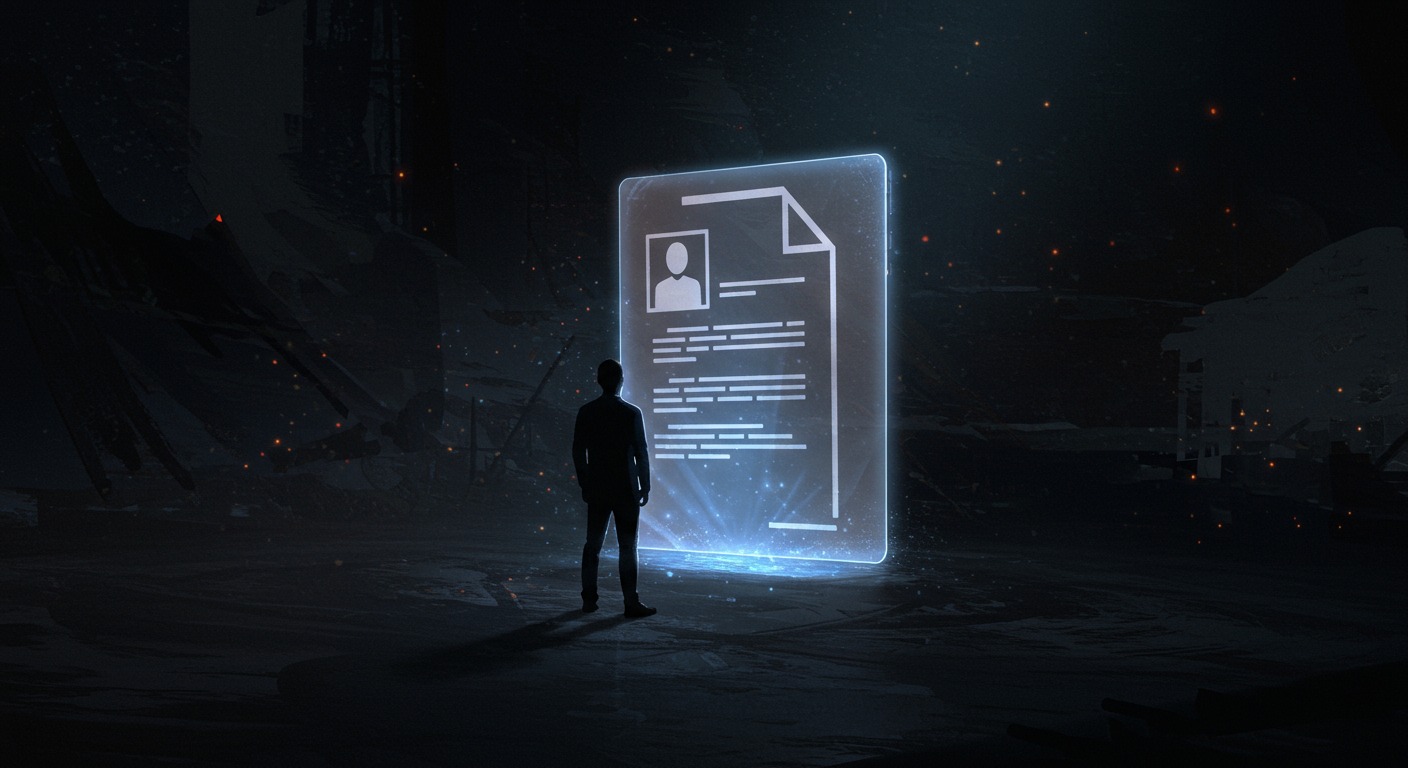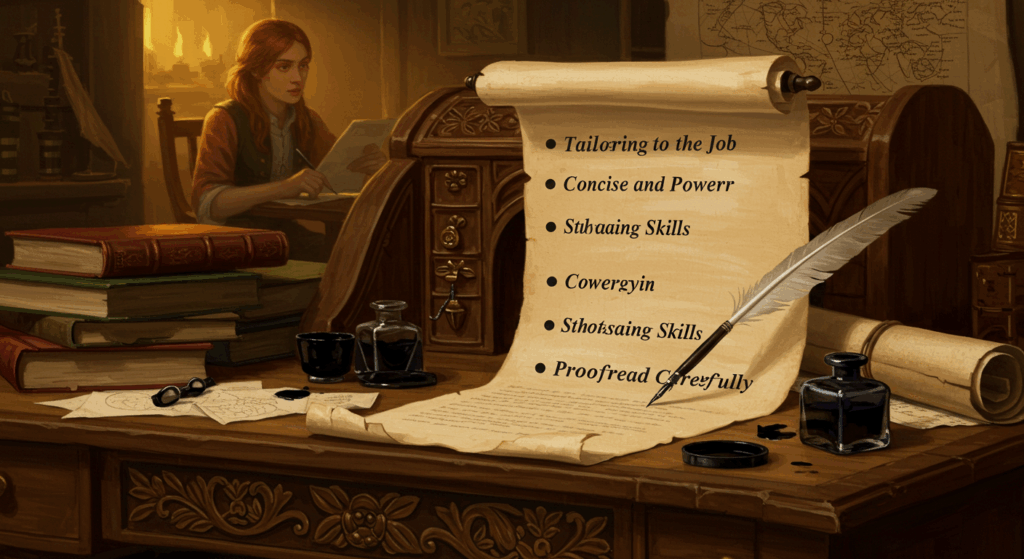Writing a cover letter can feel like opening Netflix and scrolling for 45 minutes, then watching nothing. You’re staring at a blank doc like, “What’s the purpose of this? What’s the right structure? Do I need, like, three paragraphs or twelve? Are there examples of what ‘good’ looks like that aren’t painfully corporate?”
Same. Been there. The good news? A great cover letter is simpler than you think. It’s basically a quick, human pitch that says, “I understand the job, here’s proof I can help, and I’m actually excited to do it.” That’s it. Not a thesis. Not your entire life story. Just a clean one-page note that makes a recruiter or hiring manager go, “Okayyy, let’s interview them.”
This guide walks you through the essentials with a friendly, no-stress vibe. We’ll talk purpose, structure, and share plenty of mini examples you can steal and tweak. Plus: common mistakes, specific templates, and how to sound like yourself (not ChatGPT wearing a tie). Ready? Coffee sip. Let’s go.
Why Cover Letters Still Matter (The Real Purpose)
So, what’s the actual purpose of a cover letter in 2025 when everyone’s busy and the ATS is out here scanning resumes like a bar code? Three things:
- Context: Your resume shows what you did. Your cover letter tells why it matters for this role.
- Fit: It proves you understand the company’s problems, priorities, and vibe.
- Voice: It’s a mini writing sample (yes, even if you’re not a “writer”). Can you communicate clearly, concisely, and like an adult human? Great—hired.
Think of it like a dating app opener that’s not “hey.” You’re signaling effort, alignment, and a bit of personality. And yes, plenty of employers still read them. Especiallly when your resume isn’t an obvious 1:1 match or when the role values communication and judgment (which… is most roles).
The Simple Structure That Works Every Time
We’re not reinventing the wheel here. Keep it clean, short, and scannable. A strong structure looks like this:
- Header: Your info + the date + the company/hiring manager (if you have it).
- Greeting: “Hi [Name],” or “Dear [Name],” (skip “To Whom It May Concern,” pls).
- Hook (2–3 sentences): A specific win or reason you’re excited about this job.
- Proof (4–6 sentences or 2–3 bullets): Outcomes you’ve delivered that map to their needs.
- Alignment (2–4 sentences): Show you get their product/market/team. Connect your skills to their roadmap.
- Close (1–2 sentences): Friendly, confident CTA (case study, portfolio, quick chat).
- Signature: “Best,” “Warmly,” “Cheers,” + your name.
Length: ~300–450 words. Yes, shorter is often stronger. Your goal isn’t to say everything; it’s to say the right things.
Mini Outline You Can Copy (Structure + Content)
Here’s a micro-outline to translate into your own words:
- Hi [Name],
- Hook: “I’m excited about [Role] at [Company] because [specific reason]. Recently at [Current/Last Company], I [achievement with number/impact]—relevant to your goals around [posting keyword or initiative].”
- Proof: “I [action] resulting in [outcome], and partnered with [teams/tools]. A second win: [project + result]. This maps to [responsibility in the job description].”
- Alignment: “Your focus on [mission/product/market] is especially interesting. I’ve shipped [similar thing], and I’d love to help with [initiative] to drive [metric].”
- Close: “Happy to share a 2-min Loom or quick case study. Thanks for your time—would love to chat.”
- Best, [Your Name]
That’s the skeleton. Flesh it out with your specifics.
The Purpose, Structure, Examples Trio (Overview Cheat Sheet)
- Purpose: Context + fit + voice. Don’t repeat your resume; interpret it for the role.
- Structure: Header → Greeting → Hook → Proof → Alignment → Close.
- Examples: Keep scrolling—there’s a bunch below you can tweak.
Finding the Right Voice (Professional but Actually Human)
This is where a lot of cover letters go sideways and land in generic-ville. You want friendly-professional, not “my dearest esteemed company” or “wassup fam.” Think: how you’d talk to a future teammate on a Zoom intro. A few vibe rules:
- Contractions are fine.
- Simple words beat fancy ones.
- One tasteful joke or aside (“ngl,” “hmm,” “you know?”) is okay.
- Short paragraphs are your friend.
- When in doubt, choose clarity over cleverness.
Step-by-Step: Write It in 45 Minutes (Yes, Really)
Step 1: Read the Posting Like a Detective (7 minutes)
Highlight 6–8 keywords: skills, tools, outcomes, team style. That’s your compass. Every sentence you write should align with at least one of those.
Step 2: Gather Your Receipts (10 minutes)
List 3–5 career moments that map to their needs. Add numbers if you can (growth %, time saved, revenue, users, error rate, NPS—anything). No numbers? Use scope (size of team/budget), speed (time to deliver), or quality (fewer incidents, higher ratings).
Step 3: Draft the Hook (5 minutes)
One relevant win + why you’re excited about this company. Keep it comcrete.
Step 4: Write the Proof (15 minutes)
Two small proof stories. Use the Problem → Action → Result format (PAR). Be specific. Name tools/skills from the posting when true.
Step 5: Write the Alignment (5 minutes)
Show you get their product/market/team. Mention a recent launch, audience, or business move. Tie it to what you can do in month 1–3.
Step 6: Close and Polish (3 minutes)
Short CTA + sign-off. Spellcheck. Read out loud. Save as PDF with a clear filename.
Good vs Meh: Side-by-Side Examples
Meh opening:
“I’m writing to express my interest in the Marketing Manager role at Company. I have 6 years of experience and I believe I’d be a great fit.”
Better opening (purposeful):
“Your push into creator partnerships is exactly where I’ve been winning—at Lumen, I launched two collabs that lifted affiliate-driven revenue by 27% in Q2 while holding CAC flat. That’s why the Marketing Manager role at Company jumped out.”
Meh proof:
“I handled social media and worked with the design team.”
Better proof:
“Built a weekly ‘creative lab’ with design + data to test hooks; our CTR rose from 1.4% to 2.6% in six weeks, and subscriber growth accelerated 18% QoQ.”
Meh close:
“Please let me know if you need anything else.”
Better close:
“Happy to share a 2-min Loom walking through our affiliate playbook. Thanks for reading—would love to chat.”
Concrete Examples You Can Adapt (Different Roles)
Example 1: Operations / Program Management (Structure + Results)
Hi Priya,
Your Senior Operations Manager role caught my eye because you’re scaling onboarding while maintaining NPS. At Branch, I led a cross-functional program to standardize vendor SLAs, cutting onboarding time from 21 to 12 days and lifting first-month NPS from 42 to 58.
I built a simple weekly rhythm—Monday risk check-ins, midweek metric reviews, and Friday incident retro—that reduced escalations by 31% in two quarters. We also consolidated vendor tooling (three platforms → one), saving ~$92k annually and making performance reporting real-time. This maps directly to your focus on efficiency + quality during growth.
I’m excited by your marketplace expansion and the push into mid-market accounts. I’ve led playbooks through similar transitions and can help you maintain speed without chaos, especially around handoffs and SLA visibility.
Happy to share dashboards and the rollout plan we used. Thanks for your time—would love to chat.
Best,
Jordan
Example 2: Product / UX (Purpose: user impact; Structure: hook → proof → alignment)
Hi Kim,
I’m applying for Product Designer at Astra because your new workspace experience is a perfect fit for my last sprint’s work. At Flux, I redesigned the onboarding checklist and in-app empty states, improving activation by 19% and reducing “what do I do next?” tickets by ~30%.
I run research scrappy but respectful: 5–7 user interviews → lo-fi flows → a/b with PM and Eng. We cut cognitive load by clarifying the first action, moved help docs inline, and added a “preview” state to reduce fear-of-commitment clicks. Tools: Figma, Maze, and a very opinionated component library.
Astra’s bet on team collaboration (especially shared templates) is exciting. I’d love to help you tighten the first 10 minutes and experiment with progressive disclosure. I can share a quick Loom of the checklist patterns if helpful.
Thanks for reading—hope to talk soon.
Cheers,
Lena
Example 3: Sales / Partnerships (Examples that show pipeline + relationships)
Hi Michael,
The Partnerships Manager role sounds like home. At Mono, I opened two new verticals (edtech, creator tools) and sourced 34 qualified opps in two quarters, closing $1.2M ARR with a 41% win rate. My edge is structured discovery: a one-pager that surfaces use-case, timeline, and champion influence in under 15 minutes.
I partner tight with product and success—our most successful deal happened because we co-built a lightweight pilot that cut time-to-value from 60 to 21 days. Your emphasis on land-and-expand and multi-threading is spot on; I’ve been living that motion.
I’m excited by your ecosystem approach and the recent launch of your API tier. I’d love to bring my playbook and open a few fresh channels fast.
If useful, I can share a quick opp review from the edtech vertical.
Best,
Rafael
Example 4: Entry-Level / Career Switcher (Purpose: transferable skills)
Hi Denise,
As a community ops coordinator pivoting into HR, the People Ops Assistant role at Lattice really clicks. I’ve spent two years running onboarding for volunteer cohorts (35–60 people per month), building checklists, nudges, and a weekly FAQ that cut “where do I find…?” messages by ~40%.
I’m obsessive about documentation and tidy data (Airtable + Notion + GSheets are my happy place). I also co-ran a monthly engagement survey; we boosted response rate from 56% to 82% in three cycles by shortening questions and giving quick feedback summaries—practically HR 101, but it works.
Your focus on manager enablement is 🔥. I’d love to help with calendar ops, communication templates, and smoother first-week experiences.
Happy to share my onboarding templates. Thanks for considering!
Warmly,
Maya
Formatting: Small Choices That Make a Big Difference
- Font: Calibri, Arial, Helvetica, Georgia (11–12 pt).
- Margins: 1 inch.
- Spacing: Single; extra line between paragraphs.
- File: PDF, unless the posting wants a doc or plain text.
- Filename:
FirstName-LastName-Cover-Letter-Role-Company.pdf. - Links: Include your LinkedIn or portfolio (hyperlink the text).
- Length: If it’s longer than a phone screen, it’s too long. Aim ~350 words.
The purpose of clean formatting is to be invisible. Let the structure do the heavy lifting; don’t distract with borders, backgrounds, or funky fonts.
Common Mistakes (And How to Avoid Them)
- Generic vibes. If you could send the same letter to 50 companies without edits, it’s too vague. Add a specific product/market/metric line.
- Resume paste. Don’t repeat bullets. Interpret them for this role.
- Over-apologizing. “I know I’m not qualified…”—nope. Show transferable wins.
- Buzzword soup. “Synergy, dynamic self-starter, ninja…”—yep, skip.
- Too long. Trim. The best letters are crisp.
- Typos. Spellcheck + read out loud (you’ll hear the weirdness).
- No CTA. End with momentum: a case study, portfolio, or short call.
How to Tailor Fast (20-Minute System)
- Two-swap rule: Swap the hook (first 2–3 lines) and the alignment paragraph for each company. Keep the middle proof mostly the same with minor keyword edits.
- Keyword mirror: If they say “customer activation,” use that phrase (if true), not your old team’s “onboarding completion.”
- Company detail: A recent launch, customer type, or market move—one specific line is enough.
- Month-1 value: Memntion something you can do quickly (“tidy the analytics events,” “draft a refreshed onboarding email,” “run a discovery sprint”). Managers love immediate traction.
ATS & Keywords (Without Sounding Like a Bot)
- Use 6–10 exact phrases from the job posting naturally in your letter.
- Mention relevant tools (Figma, SQL, Salesforce, HubSpot, Python, GA4, Braze, etc.) only if true.
- Keep formatting simple if pasting into a portal (plain text plays nice).
Purpose, Structure, Examples—In Action (A Compact Template)
Purpose: Context + fit + voice
Structure: Hook → Proof → Alignment → Close
Examples: Customize the bracketed parts
Hi [Name],
I’m excited about [Role] at [Company] because [specific reason—product, mission, market]. At [Recent Company], I [action] that led to [measurable result], which maps to your focus on [posting keyword/initiative].
A couple of quick wins:
- Led [project], improving [metric] by [number] in [timeframe].
- Partnered with [teams], using [tools] to [outcome].
Your recent move into [market/feature] is smart; I’ve shipped similar work and can help with [initiative] to drive [metric] in the first 60–90 days.
Happy to share a short case study (2 min) or hop on a quick intro call. Thanks for your time!
Best,
[Your Name]
Industry-Specific Pointers (So You Can Niche It Up)
- Tech/Product: Talk metrics, experiments, and user impact. Reference tooling.
- Healthcare: Emphasize compliance, accuracy, empathy, and process rigor.
- Finance: Lead with risk reduction, controls, ROI, and stakeholder trust.
- Education/Nonprofit: Outcomes + community impact + resourcefulness.
- Retail/Hospitality: Service quality, speed, training, and conflict resolution.
- Creative/Content: Your cover letter itself is a sample—be concise, clear, and show voice. Include a link to clips/portfolio.
- Data/Engineering: Keep it non-jargony; mention the stack/tools. Show you can explain complex things simply.
Edge Cases (Because Life Isn’t a Template)
- Employment gap: One sentence max, then pivot to value. “After a family leave, I’m excited to bring my [skill] back to [role].”
- Overqualified: “I’m targeting IC roles where I can ship hands-on work while mentoring lightly.”
- Career switch: Spotlight portfolio, projects, certs, and transferable wins.
- No name: “Hi Hiring Team,” is totally fine.
- They ask for salary: If required, give a range with context and pivot to role scope.
Quick “Purpose, Structure, Examples” FAQ
Do I always need a cover letter? If there’s a field for it, use it. It’s a chance to differentiate—especially if your resume isn’t an exact match.
How long should it be? Shorter than you think. 300–450 words. Focused, punchy, specific.
What about tone? Friendly-professional. Be yourself, just in “work mode.”
Can I reuse letters? Yes, with tailoring: swap the hook and alignment, mirror a few keywords.
PDF or paste? PDF unless they ask for plain text. If pasting, keep formatting super simple.
Polishing Pass: The 10-Point Final Check
- Name/company spelled right (you’d be shocked…)
- Hook is specific to them (mission/market/launch)
- Two proof points with outcomes (numbers if possible)
- Keywords mirrored from the posting
- Alignment paragraph ties your work to their roadmap
- CTA (case study, portfolio, quick chat)
- Clean structure (short paragraphs; easy skim)
- No buzzword bloat (delete “synergy” on sight)
- File name is pro (
YourName-Cover-Letter-Role-Company.pdf) - Read out loud (fix the weird sentence you’ll hear immediately)
Mini Gallery of Closers (Choose Your Flavor)
- “Happy to share a 2-min Loom walking through the project.”
- “I can send a brief teardown of your onboarding ideas if useful.”
- “Thanks for reading—excited to chat when you’re ready.”
- “I’d love to help you ship [initiative] in the first 60 days.”
- “Appreciate your time, and congrats on [recent launch/award].”
Three Short Cover Letter Examples (Different Tones)
Direct & Data-Driven
Hi Alia,
I’m applying for the Lifecycle Marketer role. At Wisp, I rebuilt onboarding emails and event triggers, increasing activation by 19% and week-4 retention by 7 pts. We held CAC flat while ARPU rose 11% via pricing tests. Tools: GA4, Braze, SQL.
Your push into B2B self-serve is exactly where I’ve been operating. I can help craft experiments for activation → expansion, and I’d love to share a 2-min Loom on our pricing wins.
Best, Rowan
Warm & User-Centric
Hi Jay,
I found your product while looking for easier ways to manage team rituals (our standups were… chaotic). The Product Analyst role clicked because I’ve been building dashboards that actually change behavior. At Lume, a weekly “decision board” cut “oops” deployments by 23% and sped up postmortems.
I love your mission to make teamwork calmer. I can help tidy event tracking, refine onboarding KPIs, and get quick wins on “time-to-value.” Happy to send a short case study.
Warmly, Bea
Early Career / Intern
Hi Chris,
I’m applying for your Design Intern role. In school, I led a capstone project to simplify campus ride-sharing, running 10 interviews and shipping a hi-fi flow that cut steps by ~30%. I know Figma, Framer, and basic prototyping, and I’m quick on feedback loops.
Your recent push into creator tools is exciting. I’d love to contribute to onboarding and empty states; I can share a 90-second walkthrough. Thanks for your time!
Cheers, Kai
Final Word on Confidence (You’ve Got More Than You Think)
Here’s the truth I wish someone told me earlier: a cover letter isn’t about proving you’re perfect; it’s about proving you’re relevant. If you can show you understand the purpose of the role, follow a clear structure, and point to a couple of practical examples where you delivered outcomes, you’re in the top tier already. Sprinkle in a bit of you—your voice, your curiosity, your momentum—and that’s the letter most hiring managers actually want to read.
Friendly Wrap-Up
You don’t need to write the best cover letter on Earth. You just need one that’s focused, human, and aligned. Use the purpose–structure–examples trio, tailor the hook and alignment for each company, and end with a confident CTA. Then submit it and move on—don’t spiral-edit for three days. Progress over perfection, always.
Now open that doc (yes, now), paste the template, and write the first three lines. Apply to one role before your coffee gets cold. You’ve so got this—let’s go land the interview. 💪









